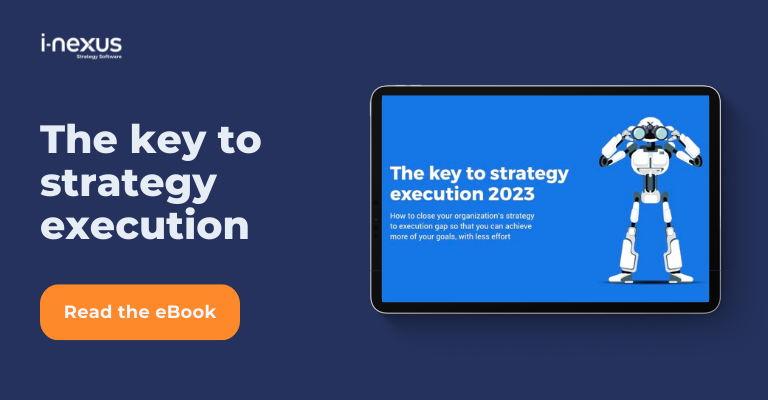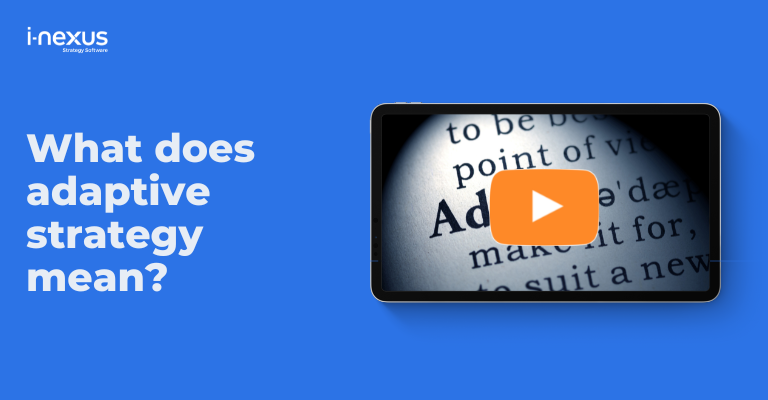The time has come for a new approach to creating and managing our strategies. Leaning on Agile principles, Business Agile is the most adaptive way for leaders to capitalize on the ever-shifting landscape of the 2020s. Here's what it means to embrace Business Agile in your organization.
“If I had to identify a theme at the outset of the new decade it would be increasing uncertainty.”
Kristina Georgieva, Managing Director of the IMF, Peterson Institute for International Economics, January 17, 2020
The 2020s are a decade of uncertainty. Political and economic uncertainty in the US and EU set the scene for the decade, but they’re not alone.
No sooner than the prediction was made, Covid-19 emerged, and with it came the erosion of any last certainty stubbornly remaining and substantial disruption.
In less than two years, we transitioned from an era of “new normal” to a time of “no normal.”
"76% (of CxO surveyed) indicate that COVID-19 will impact, or even cause them to pivot, their organizations’ medium- to long- term strategy"
Can your strategy pivot faster than the speed of change? Ernst & Young Parthenon
With this change comes a key question to any person tasked with planning in their organization: can your planning processes accommodate uncertainty or will it still rely on certainty and predictability?
In this blog, we explore the implications of uncertainty on planning – strategic and operational - and the imperative for “Business Agile” – the acceptance and embracing of uncertainty by building a key new organizational capability, responsiveness.
What does Business Agile mean?
We’re not talking about Agile portfolio or project management. Those disciplines take their places at the table in this new world. However, Business Agile is complementary to those disciplines.
Leaning on Agile principles, Business Agile ensures that your organization’s strategy and strategic and operational plans can be managed in a much more agile and continuous manner.
And, as we’ll see, by taking a more continuous approach, your organization can become much more responsive to change and switch resources and attention no matter the scenario.
A different approach is needed
“A traditional strategy approach will not help organizations survive in uncertain conditions, because it becomes outdated quickly, is slow to respond to changes and depends on certainty”
Make your strategy more adaptive for an uncertain environment, Cox & Skyttegaard, Gartner Research, 2 July 2020
Clearly, the traditional approach to annual strategic planning and case-by-case operational projects, and continuous improvement needs to accommodate this new reality.
It is battle-tested in a slower-moving world where assumptions were safe, risks were known and understood, and market disruption was visibly signposted, allowing sufficient time to adapt.
In that world, planning a year’s worth of strategic activity, aligning improvement priorities and projects to these strategic themes, and hunkering down for the execution of that year’s activity, was a safe bet.
Both strategy and plans remained largely untouched, assumed to be failsafe for those twelve months.
Naturally, management attention zeroed in on performance to plan without necessarily questioning the plan itself or its governing strategy.
That must sound like a sweeping generalization and harsh. But processes must evolve and adapt to remain relevant, just like markets, products, and organizations.
What changes must we make to the annual strategic planning process to guarantee its relevance in this emerging world?
Catching the need to change course
The main challenge with annual strategic and operational planning is that it assumes strategy will not change in those 12 months.
To understand whether a strategy needs to adapt, conscious strategic reviews are critical, forcing the discussion away from performance to the shape of plans and onto the strategy itself.
Introducing regular strategic review sessions
Making this change is relatively straightforward with the introduction of regular strategic reviews. More challenging is gathering reliable market and competitive intelligence that might influence the strategy or signpost broader market disruption.
Historically, a research team might gather this information from primary and secondary research; a labor-intensive task that subsequently limits available resources for analysis, interpretation, and curation.
Nowadays, AI-enabled software can automate the delivery of (close to real-time) targeted market intelligence: from competitive analysis to changes in regulations and legislation.
That leaves the question of what topics or events to monitor for strategic disruption.
What strategic disruptions should you be monitoring?
Many organizations maintain a list of strategic issues that might include strategic (planning) assumptions, risks, threats, or opportunities ripe for exploitation.
The nature of these is dependent on your industry, your competitors, and those fringe players who blur the lines between your industry and theirs.
Once identified, you can begin to automate the strategic disruption scanning process, similar to how search engine marketers would for keyword fluctuations they create content for.
Market and competitive intelligence software will use search terms based on these strategic issues plus known competitors, industry publications, and more.
Responding to strategic curveballs
“The problem is not with our organizations realizing that they need to transform; the problem is that organizations are using managerial frameworks and infrastructure models from past revolutions to manage their businesses in this one”
Mik Kersten, creator of Eclipse
Getting an early distant warning of a need to change course is one thing. What follows – impact analysis and response – is another matter.
Responding might require a revised strategy and annual strategic plan and portfolio of projects mid-stream through the planning and delivery cycle.
For this reason, companies are exploring the decoupling of the planning cycle from the delivery cycle – the evolution of scenario planning.
What evolved scenario planning looks like
Scenario planning necessitates an ability to look at multiple angles and possibilities. And, with Business Agile, organizations’ planning cycle might remain twelve months, but the delivery of the plan itself might be incremental and quarterly.
In between delivery cycles, the strategy office and PMO has the opportunity both to reflect on performance in the prior cycle (a “retrospective”) as well as look ahead at the next delivery cycle.
Any changes in the strategic and operational plans can be implemented in response to internal or external factors.
We call this new capability to respond to changing conditions “Business Agile.”
Business Agile is the ability to respond to change
It is the application of key Agile principles to strategy and strategic planning, as opposed to the delivery of the strategic plan.
Rather than replace the annual strategic planning process, these concepts equip this process with much-needed responsiveness in more uncertain times.
Going beyond the planning process
As we move throughout the Business Agile concept, our next blog explores how types of strategy – experiment, option, and minimum viable – can be executed with an Agile mindset for your organization.
As for now, we recommend you explore strategic reviews and their role as an early distant warning system. And think about how you might incrementally deliver the annual strategic plan and accommodate course correction.
To learn more, watch our accompanying webinar, available below.
Learn more about Business Agile and strategy execution
Take the next steps in your journey to embracing Business Agile by exploring our strategy execution resource hub or any of the below:
- Key to strategy execution eBook: Read how companies like Danaher and HP have mastered strategy execution and what you can learn from them.
- What does it mean to be Business Agile?: Leap into the future of strategic planning and execution with this fascinating insight.
- How AI and Machine-Assisted Learning will help strategy execution: As Artificial Intelligence becomes a mainstay in our lives, read how AI and machine-assisted learning will evolve to support your strategy execution.
About the author
James Davies is i-nexus’ Chief Product Officer. As an experienced software executive with 20 years of experience working in Silicon Valley, USA, James has held senior leadership roles in three venture capital-backed software start-ups (including CEO, CPO, and Chairman). He has delivered management consulting services to some of the world’s largest technology companies.
If you’d like to talk more about the future of strategy execution, reach out to him on james.davies@i-nexus.com or connect with James on LinkedIn for the latest insights




